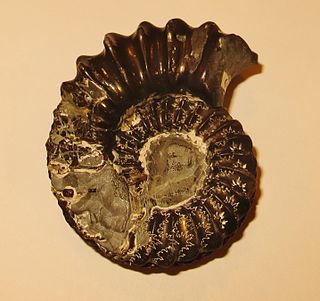
Australiceras is an extinct ammonite genus from the upper part of the Early Cretaceous, Aptian stage, included in the family Ancyloceratidae.
Aioloceras is an ammonite, order Ammonitida, from near the end of the Early Cretaceous. The shell is compressed with the outer whorl covering much of the previous. Sides are slightly convex, converge toward a narrowly ached venter. Inner whorls have sharp falcoid ribs, outer are smooth. Umbilical tubercles are lacking. Similar related forms include Neosaynella and Cleoniceras.

Aspidoceras is an extinct ammonoid cephalopod genus belonging to the family Aspidoceratidae.
Beyrichites is an extinct genus in the ammonoids cephalopod, order Ceratitida from the Lower and Middle Triassic of southern Europe, Asia, and western North America.

Placenticeras is a genus of ammonites from the Late Cretaceous. Its fossils have been found in Asia, Europe, North and South America.

Cryptogemma phymatias is a species of sea snail, a marine gastropod mollusk in the family Turridae, the turrids.

Calliotropis aeglees is a species of sea snail, a marine gastropod mollusk in the family Eucyclidae.

Calliotropis calcarata is a species of sea snail, a marine gastropod mollusk in the family Eucyclidae.

Carenzia trispinosa is a species of sea snail, a marine gastropod mollusk in the family Seguenziidae.

Calliotropis tiara is a species of sea snail, a marine gastropod mollusk in the family Eucyclidae.

The Trachyceratidae is an extinct family of ceratitid ammonoid cephalopods.
Clionitidae is a family of generally evolute, Upper Triassic, ammonoids with a ventral furrow usually bordered by rows of tubercles and whorl sides ornamented by sigmoidal ribs which may bear spiral rows of tubercles. The suture is ceratitic.

Forresteria is an extinct genus of cephalopod belonging to the subclass Ammonoidea. They flourished during the late Turonian and early Coniacian of the Late Cretaceous, and were global in extent. Forresteria alluaudi and Forresteria hobsoni are considered marker fossils for the lower Coniacian in the American West.
Pachyceratidae is a family of Perisphinctoidean ammonites from the upper Middle - and lower Upper Jurassic. Genera within the Pachyceratidae have shells that are in general moderately involte but with most of the inner whorls exposed; whorl sections subquadrate to subtrapezoidal, with rounded venter. Ribbing is strong, in some sharp. Primary ribs typically branch above mid flanks into twos, threes, and even fours.
Eoderoceras is an evolute, round whorled ammonite from the Lower Jurassic with an outer row of distinct spines, and in some, an inner row of tubercles, on either side; ribs only on the inner whorls.

Turrilites is a genus of helically coiled ammonoid cephalopods from the lower part of the Upper Cretaceous ; generally included in the Ancyloceratina. Previously it was included in the ammonoid suborder, Lytoceratina.
Sirenites is a genus of ammonoid cephalopods from the Upper Triassic included in the Ceratitida, and type for the trachyceratid subfamily Sirenitinae.
Vredenburgites is a genus of ceratitids in the family Trachyceratidae. Its shell has numerous, thin, flexious ribs.

Hecticoceras is an ammonite genus belonging to the haploceratoid family Oppeliidae, that lived during the Middle and Late Jurassic, from the Callovian. Hecticoceras may be seen as a series of some nine subgenera, beginning with the lower Callovian H. (Hecticoceras) and H. (Hecticoceratoides) and ending with the lower Oxfordian H. (Pseudobrightia) and H. (Eochetoceras). Hecticocerassensu lato and Prohecticoceras from the underlying Bathonian form the oppeliid subfamily, Hecticoceratinae.
Neocardioceras is a genus of evolute acanthoceratid ammonites from the uppermost Cenomanian, Upper Cretaceous, of Europe, western U.S. and Brazil.











